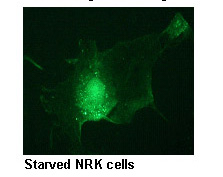Anti-GABARAP pAb
| Code | Size | Price |
|---|
| MBL-PM037 | 100 ul | £341.00 |
Quantity:
Prices exclude any Taxes / VAT
Overview
Host Type: Rabbit
Antibody Isotype: IgG
Antibody Clonality: Polyclonal
Regulatory Status: RUO
Target Species:
- Hamster
- Human
- Mouse
- Rat
Applications:
- Immunocytochemistry (ICC)
- Western Blot (WB)
Shipping:
4°C
Storage:
-20°C
Images
Documents
Further Information
Applications:
WB - 1:1000 (chemiluminescence detection system) ICC - 1:100
Background:
Autophagy is a process of intracellular bulk degradation in which cytoplasmic components including organelles are sequestered within double-membrane vesicles that deliver the contents to the lysosome/vacuole for degradation. LC3, GABARAP (γ-aminobutyric-acid-type-A-receptor-associated protein), and GATE-16 (Golgi-associated ATPase enhancer of 16 kDa) have been identified as a homologue of yeast Atg8. These homologues have been characterized as modifiers in reactions mediated by hAtg7 (an E1-like enzyme) and hAtg3 (an E2-like enzyme) as in yeast Atg8 lipidation. These homologues also generate form II, which are recovered in membrane fractions. Generation of the form II correlates with autophagosome association. These results suggest that all mammalian Atg8 homologues receive a common modification to associate with autophagosomal membrane as the form II.
Formulation:
100 ul volume of PBS containing 50% glycerol, pH 7.2. No preservative is contained.
Gene IDs:
Human: 11337 Mouse: 56486 Rat: 58974
Immunogen Translated:
GABARAP N-terminal synthetic peptide carrier protein binding
Reactivity:
This antibody reacts with GABARAP on
Western blotting and Immunocytochemistry. It does not
react with LC3 and GATE16.
Shelf Life:
1 year
Source:
This antibody was purified from rabbit serum
using affinity column. The rabbit was immunized with
carrier protein conjugated synthetic peptide at the
N-terminus region of GABARAP.
Target:
GABARAP
References
1) Klionsky, D. J., et al., J. Cell Sci. 118, 7-18 (2005)
2) Tanida, I., et al., J. Biol. Chem. 277, 13739-13744 (2002)




